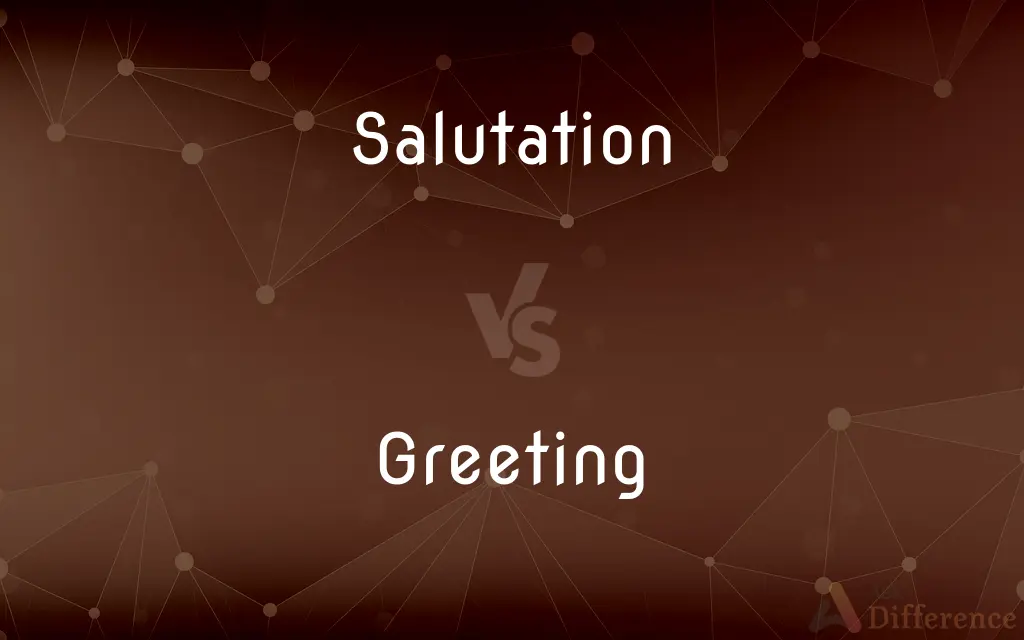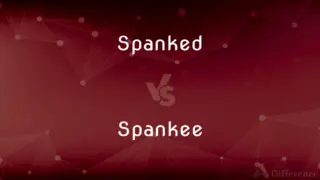Salutation vs. Greeting — What's the Difference?
Edited by Tayyaba Rehman — By Maham Liaqat — Updated on March 5, 2024
Salutation is a formal expression of greeting or respect, often used in written communication, while greeting is a more general term for any message or gesture of goodwill.

Difference Between Salutation and Greeting
Table of Contents
ADVERTISEMENT
Key Differences
Salutation often refers to the specific phrases used at the beginning of a letter or email, such as "Dear" or "To," indicating respect and formality. On the other hand, greeting encompasses a wider range of expressions used in both written and verbal communication, including simple phrases like "Hello" and "Hi."
While salutations are typically used in formal or professional contexts, requiring a certain level of decorum, greetings can be casual or formal, adaptable to the context of the interaction, whether it's a casual meeting with a friend or a formal business meeting.
Salutations often follow a set structure in professional communications, including titles and last names, to show respect and formality. Greetings, however, can be much more flexible, allowing for first names, nicknames, or even non-verbal gestures like a wave or a smile.
Salutations are crucial for setting the tone of the message, indicating the formality and respect towards the recipient. Meanwhile, greetings in verbal communication serve as an icebreaker, establishing a friendly atmosphere from the start.
Salutations and greetings both play a role in initiating communication, but the choice between them depends on the level of formality required by the situation. While a salutation sets a formal tone, a greeting can either maintain this formality or introduce a more relaxed atmosphere.
ADVERTISEMENT
Comparison Chart
Usage Context
Formal written communication
Both formal and informal communication
Examples
"Dear Mr. Smith," "To Whom It May Concern,"
"Hello," "Hi," "Good morning,"
Structure
Often includes titles and last names
Can be flexible, using first names or even non-verbal
Communication Type
Primarily written
Both written and verbal
Purpose
To show respect and formality
To express goodwill or acknowledgement
Compare with Definitions
Salutation
A respectful or courteous acknowledgment in written communication.
The salutation 'To Whom It May Concern' is commonly used in formal letters.
Greeting
A word or gesture of welcome or recognition.
She greeted her friend with a warm hug.
Salutation
A formal expression of greeting in letters or emails.
Her letter started with the salutation 'Dear Committee Members.
Greeting
An informal expression used to acknowledge someone's presence.
A simple 'hi' was his usual greeting to neighbors.
Salutation
A word or phrase indicating respect or politeness.
The traditional salutation in a business email is 'Dear' followed by the person's title and surname.
Greeting
A message of goodwill at the beginning of a conversation.
His email started with a friendly greeting, making the tone casual.
Salutation
A gesture of respect or reverence.
He offered a salutation before starting his speech.
Greeting
An act of communication indicating the beginning of interaction.
The meeting started with greetings and introductions all around.
Salutation
A word or phrase of greeting used to begin a letter or message.
Greeting
A sign of acknowledgment in social settings.
Upon entering the room, he offered greetings to everyone present.
Salutation
The opening phrase in a letter or email indicating formality.
The formal salutation set the tone for the rest of the correspondence.
Greeting
Greeting is an act of communication in which human beings intentionally make their presence known to each other, to show attention to, and to suggest a type of relationship (usually cordial) or social status (formal or informal) between individuals or groups of people coming in contact with each other. Greetings are sometimes used just prior to a conversation or to greet in passing, such as on a sidewalk or trail.
Salutation
A salutation is a greeting used in a letter or other written or non-written communication. Salutations can be formal or informal.
Greeting
A word or gesture of welcome or salutation.
Salutation
A polite expression of greeting or goodwill.
Greeting
A conventional phrase used to start a letter or conversation or otherwise to acknowledge a person's arrival or presence.
It's polite to begin a letter with a greeting, but this practice is less common in email.
Salutation
Salutations Greetings indicating respect and affection; regards.
Greeting
Expression of kindness or joy; salutation at meeting; a compliment from one absent.
Write to him . . . gentle adieus and greetings.
Salutation
A greeting, salute, or address; a hello.
Salutation
The act of greeting.
Common Curiosities
Can a salutation be used as a greeting?
Yes, a salutation can serve as a greeting in formal written communications.
Are salutations necessary in all emails?
While not always necessary in informal emails, salutations are expected in formal and professional emails to show respect.
Can greetings be non-verbal?
Yes, greetings can be non-verbal, such as a smile, a nod, or a wave.
How do I choose the right salutation for a letter?
Choose based on the formality of the situation, the relationship with the recipient, and any specific conventions of the recipient's culture or organization.
Is "Hello" considered a salutation?
"Hello" is typically considered a greeting, though it can be used as a casual salutation in emails or messages.
Is it appropriate to use a casual greeting in a professional setting?
It depends on the workplace culture, but generally, it's best to use formal greetings in professional settings.
Can the choice of greeting affect the tone of a conversation?
Yes, the choice of greeting can set the tone for the entire conversation, influencing its formality and warmth.
Are there specific greetings for different times of the day?
Yes, greetings such as "Good morning," "Good afternoon," and "Good evening" are tied to specific times of the day.
What is the difference between a greeting and a farewell?
A greeting is used to acknowledge someone's presence or to begin a communication, while a farewell is used to express good wishes when parting.
Why is it important to use a salutation in a business letter?
Using a salutation in a business letter shows professionalism, respect, and sets the tone for the communication.
Can I use emojis as part of a greeting in professional emails?
It's generally not recommended to use emojis in professional emails, as they can be seen as too casual or unprofessional.
How do greetings vary across cultures?
Greetings can vary significantly, with different cultures using specific phrases, gestures, or customs to greet others.
What is the purpose of a salutation in a letter?
The purpose is to respectfully address the recipient, indicating the formality and respect inherent in the communication.
How has the use of greetings and salutations changed with online communication?
Online communication has led to more casual forms of greetings and salutations, especially in less formal contexts.
Are there different greetings for formal and informal letters?
Yes, formal letters often use specific salutations like "Dear Mr./Mrs.," while informal letters might start with a simple "Hello" or "Hi."
Share Your Discovery

Previous Comparison
Keto vs. Ket
Next Comparison
Spanked vs. SpankeeAuthor Spotlight
Written by
Maham LiaqatEdited by
Tayyaba RehmanTayyaba Rehman is a distinguished writer, currently serving as a primary contributor to askdifference.com. As a researcher in semantics and etymology, Tayyaba's passion for the complexity of languages and their distinctions has found a perfect home on the platform. Tayyaba delves into the intricacies of language, distinguishing between commonly confused words and phrases, thereby providing clarity for readers worldwide.














































